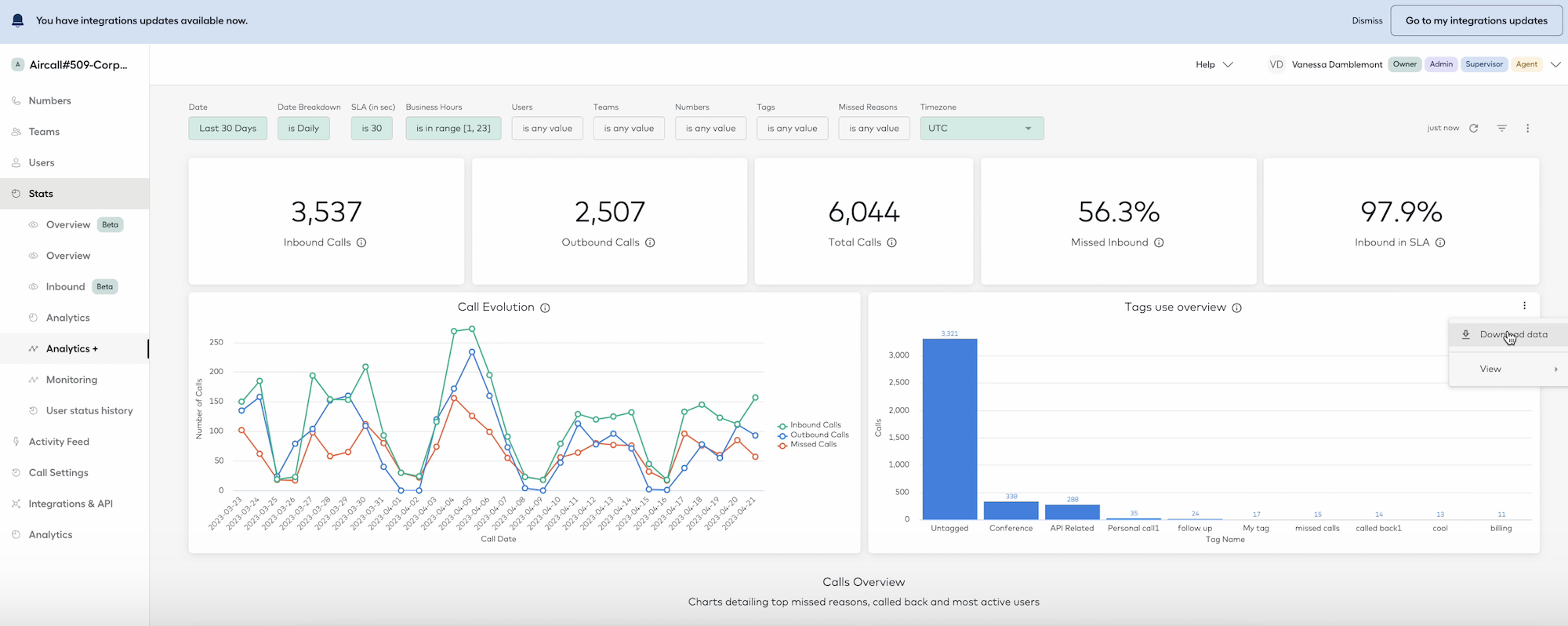Today’s customers expect to contact your company through multiple communication channels. Additionally, many companies benefit from proactive outreach across touchpoints like emails and texts. Blended contact center software provides these capabilities.
In this article, we’ll cover everything you should know about blended contact centers.
- Overview
- How to set up
- Essential features
- How AI is transforming it
- Benefits
- Blended vs Omnichannel
- Challenges
- Impact on customer service
- Key metrics to monitor
- Case studies
- FAQs
What is a Blended Contact Center?
A blended contact center is a communication system for inbound and outbound customer interactions. Usually a cloud-based software system, blended contact centers let agents connect with customers on multiple channels: voice calling, SMS texting, email, live chat, and social media messaging. Agents can manage all these inbound and outbound channels from one desktop dashboard.
Non-blended contact centers, called inbound or outbound, only focus on one call direction–making or receiving calls. Or, non-blended contact centers may only focus on one channel.
How to Set Up a Blended Contact Center?
Set up a blended contact center by subscribing to a hosted omnichannel contact center solution. Contact Center as a Service (CCaaS) platforms offer single-channel call centers and omnichannel infrastructure, which combines all the communication channels into one dashboard.
Here’s a more detailed step-by-step breakdown:
- Subscribe to a contact center software: Select a hosted call center or omnichannel CCaaS platform, most of which are blended–combining inbound and outbound service
- Set up users and phone numbers: Once you install the software, invite agents by email and purchase phone numbers. When the numbers are activated, agents can make and receive calls through the desktop computer.
- Customize call routing: Set up IVR menus, virtual agents (IVA), and other call distribution (ACD) tools that automatically navigate inbound callers to the right agent. Call queues and ring groups help organize overflow callers.
- Connect with a CRM system: Link your CCaaS software with CRM systems like Salesforce and HubSpot, to leverage customer data for automations and better service
- Create automations and workflows: Create triggers that automate communications like proactive emails, sales campaigns, follow-up surveys, and more
Essential Features of a Blended Contact Center
A blended contact center bundles many communication channels, call distribution tools, queueing, analytics, AI support features, CRM integrations, workforce management tools, and more.
Here’s a breakdown of essential features to look for in a blended contact center:
Omnichannel Communication
A blended contact center bundles dozens of communication channels: VoIP telephony, SMS texting, email, live chat and chatbots, video, and social media messaging (like Facebook Messenger and Instagram DMs) across many platforms. Agents use these channels to initiate and receive customer communications through the software dashboard.
Intelligent Call Routing and IVR
Automated call distribution (ACD) and interactive voice response (IVR) systems route and send customers to the right department or agent based on input, history, or previous behavior. These tools cut wait times and foster stronger first-contact resolution rates. Virtual agents can do the same across digital channels, collecting customer info and triaging requests before an agent is involved.
Call Queueing
Call queues organize inbound callers into hold queues so agents can manage overflowed calls. Each department and agent may have their own queue, so agents can see all the calls on hold. Many CCaaS software systems enable queue callbacks, allowing the customer to hang up and keep their place in line with a callback when the agent is available.
Unified Agent Workspaces
Blended agents work best with an intuitive and singular dashboard that allows them to see multichannel conversations, access customer history and data, scan the knowledge base, and get AI Agent assistance when needed. A unified workspace cuts on app switching and cuts down on clutter.
Agent Assist
Proactive agent assist tools take AI and highlight relevant knowledge base articles, suggest empathetic responses, and summarize previous interactions while the agent is still on the call or chat. These features keep agents speedy, accurate, and compliant to both company policies and regulatory requirements.
Real-Time Sentiment Detection
Speech and text analytics evaluate sentiment as the interaction unfolds, alerting supervisors to frustrated customers or coaching agents on tone and empathy. This enables proactive support and escalations before issues spiral.
Analytics & Performance Insights
Smart platforms will track real-time and historical KPIs like average handle time, first call resolution rates, CSAT scores, and channel usage statistics. AI-powered analytics will also underscore intent trends, keyword patterns, and service gaps to help you refine and build out agent coaching and customer experience strategies and campaigns.

Chatbots and Virtual Agents
Build automated intelligent virtual agents (IVA) that provide customers with self-service across digital channels. Embed chatbots into your website, or automate conversations on SMS and social media. Most blended CCaaS systems offer a drag-and-drop flow tool to customize and test these conversations.
IVA systems interact with customers naturally and can handle rich services: booking appointments, answering questions, routing tasks, and even handling payments.
Workforce Engagement Tools
Built-in workforce engagement management features should include agent scheduling, forecasting, quality assurance, and coaching. These tools will be informed by performance analytics and sentiment data to improve overall customer experience, retention rates for both customers and employees, and agent performance.
Auto Dialers
Outbound auto-dialers use lead campaign lists, such as from your CRM system, to automate the customer outreach process for sales teams. Sales agents no longer have to listen to rings, busy signals, or voicemails, since the auto dialer connects agents only when a real human answers the phone.
How AI is Transforming Blended Contact Centers
AI is rebuilding the way blended contact centers work by making interactions smarter, speedier, and personalized per customer. Whether it’s recognizing customer intent to coaching agents as they handle customer inquiries, AI-driven tools are improving customer satisfaction and making your agents better representatives for your company.
AI for Intent Recognition and Predictive Routing
AI-enabled natural language processing (NLP) detects your customers’ intent based on initial input (both spoken and written) and routes them to the best capable resource. This can be either live agents or calibrated self-service workflows. A study found that AI routing can improve fist contact resolution by up to 30% and cut average handle times by 25%.[*]
Generative AI Copilots Supporting Blended Agents
Generative AI tools work as intelligent copilots to assist your agents across both phone and digital channels. These Agent Assist programs will summarize past interactions, draft messages in real time, suggest next best steps, and offer empathetic language suggestions. Agents get to focus on high-value conversations while cutting down on repetitive tasks. Research shows that 75% of customer service agents will use some form of AI support by the end of the decade.[*]
Speech and Text Analytics Powering Real-Time Insights
Advanced speech and text analytics tools tag, analyze, and transcribe each and every interaction point for sentiment, keywords, intent, and compliance. Supervisors get a close-up look at escalation risks and friction-laced touchpoints as they happen, while AI-powered coaching tools give your agents real-time feedback and prompts to adjust tone and messaging instantaneously. Research finds that companies adopting real-time analytics increased in CSAT scores by 20% within just six months.[*]
Automated QA and Performance Scoring
AI has improved upon older antiquated methods like random call sampling by giving organizations 100% coverage on interactions for quality assurance purposes. Modern QA tools will automatically score interactions based on script adherence, compliance, empathy, and other KPIs that you can granularly look for, ideal for hybrid and remote teams.
Proactive Outreach through AI-Enhanced Engagement
AI can anticipate on top of responding, your contact center should leverage AI to drive proactive outreach, finding moments when customers are likely to need help or be available for upsell opportunities. Whether it’s follow-up messages after incomplete purchases, personalized support, or renewal reminders, AI systems can schedule timely and relevant interactions across all channels before your customer thinks of reaching out. Proactive service can cut inbound call volume by up to 20% while boosting retention rates by as much as 15%.[*]
Benefits of Implementing a Blended Contact Center Model
Implementing a blended contact center leads to better customer service, stronger customer insights, and more sales opportunities. The dashboard also simplifies the agent’s and supervisor’s experience, leading to a more effective and happier staff.
Here are the benefits that a blended contact center offers over a traditional call center:
Channel Flexibility
A blended contact center lets you connect with your customers across multiple channels, providing added flexibility. While 76% of customers still prefer to contact customer support via the phone, many prefer the convenience of SMS or live chat.
You can connect with customers via your app or website, catching customers when they’re looking at products or services.
Self-Service and Customer Convenience
Self-service tools like chatbots and IVR menus offer customer convenience because customers can reach out to you whenever they want. The automated service lets customers skip hold queues for faster issue resolution. 87% of millennials say convenience is important to them.
Increased Sales
Tools like CRM integrations, workflow automations, and outbound auto-dialers identify when leads are ready to move forward in the sales process. Initiate proactive outreach like welcome emails, discounts, and outbound calls–increasing the number of converted leads and sales made.
More Effective Agents
The blended contact center dashboard leads to more effective agents, compared to a regular one-way call center. The blended omnichannel dashboard lets agents handle tasks across all channels, switching between them with one click. CRM integrations enable more customer context and capabilities, letting agents handle rich services like appointment booking and secure payments.
More efficient agents may allow companies to save money by reducing staff size, as AI is expected to catalyze a 20-30% reduction in customer support agents by 2026.
Deeper Customer Insights
Blended call centers provide a much deeper understanding of your customers and their needs. AI uses call transcriptions to identify how your customers feel, the keywords they use most often, the IVR decisions they make, and the reasons they call. CRM data helps you track each customer’s journey, noting patterns in their lead status and purchasing behavior.
These insights help you refine your staffing, customer service, and business decisions based on rich data.
Blended vs. Omnichannel Contact Centers
While terms like “blended” and “omnichannel” feel interchangeable, they refer to very different concepts in regards to contact centers. Both carry different strengths and strategies for your business needs.
We’ve broken it down to a simple overview table:
| Blended Contact Center | Omnichannel Contact Center | |
| Agent Workflow | Agents handle both inbound and outbound tasks | Agents engage across all channels with unified interaction history |
| Channel Support | Multiple channels (voice, SMS, chat, etc.) supported, but may operate in silos | Fully integrated channels with shared context across touchpoints |
| Customer Experience | May require customers to repeat themselves when switching channels | Seamless transitions between channels with persistent context |
| Technology Integration | May use separate tools for routing, analytics, CRM, etc. | Centralized platform integrates all systems and data |
| Use Case Fit | Ideal for operational flexibility and maximizing agent productivity | Ideal for complex journeys and delivering consistent CX at scale |
| Agent Tools | Tools may vary per channel; switching between tabs common | Unified agent workspace with conversation history across all channels |
| Routing & Handoff | Channel-based routing; basic queueing | Context-aware routing with cross-channel task management |
| Examples | Small-to-mid-sized teams needing call/chat/email coverage | Enterprises with high-volume, multi-touch journeys |
What Makes an Omnichannel Contact Center Different?
Omnichannel contact centers are more oriented towards customer experiences across every touchpoint. Unlike blended contact centers which toggle between inbound and outbound tasks through silos where not every agent is on the same page, omnichannel platforms let agents see the full history regardless of channel. These are more ideal for large operations and businesses with complex customer journeys where customers are likely to move across touchpoints.
Who Needs a Blended Contact Center vs. Who Needs an Omnichannel Contact Center
- Choose a blended contact center if you want to increase agent productivity and efficiently manage multichannel traffic with an agile smaller team with fewer resources
- Choose an omnichannel contact center if your customers demand consistency across touchpoints or if you operate in a high-touch, high-expectation industry
Challenges You May Face with a Blended Contact Center
While blended contact centers offer more channels and task-routing workflows, they involve a more complicated setup than traditional contact centers. Setting up routing, configuring phone numbers, and connecting integrations can be a frustrating process.
Here are a few of the challenges you may face with a blended contact center:
- IT requirements: Many blended CCaaS products require some coding and development experience to get everything set up, meaning you may need a developer on staff
- Complicated setup: Due to the increased number of features and routing workflows, blended centers generally have a more complicated setup process
- Learning curve: Advanced features like AI, analytics, and workforce management can often take several weeks for new users to develop fluency
- More agent skills required: While one-channel or one-direction call centers enable agents to specialize in just a few types of interactions, blended CCaaS agents must be able to handle multiple channels and interaction types
- Costly: Modern blended solutions include cutting-edge features like AI support and automated workflows. These advanced solutions can cost up to $100 more, per month per user, than traditional call centers.
How Blended Contact Centers Improve Customer Service
Blended contact centers improve customer service by providing more flexibility and convenience for your customers. This improved service is part of why the omnichannel market is expected to hold a 13.6% annual growth rate through 2030.
- Multiple channels: With multiple channels, customers can reach out to you through the medium that works best for them
- Proactive outreach: The proactive and outbound tools, like auto-dialers and automated surveys, help your company reach out to customers and leads with reminders and discounts that may benefit them
- Workflow automations: Blended contact centers let you automate interactions like follow-up surveys, appointment reminders, welcome emails, and other notifications to serve more customers over time
- Quicker service: IVR menus and virtual agents ensure that inbound customers reach the right department on the first try, regardless of the channel they use
Blended Contact Center Metrics You Should Monitor
When building and monitoring your customer service plan, track a few core metrics that indicate how well your contact center functions. Metrics like customer satisfaction score, call resolution rate, agent activity, and channel usage provide valuable insights about your level of customer service.
Here are the most important metrics to monitor within your blended contact center:
- Customer satisfaction score: An advanced and AI-based metric, CSAT scores indicate how satisfied your customers are following their interactions with your company
- Call resolution rate: Call resolution rate uses call transcripts and agent notes to determine the percentage of inbound customer issues that agents resolve
- Daily call volume and channel usage: Tracking daily call volume and messages provides an overall picture of contact center activity, helping you track how well your company scales and how many agents you need to staff
- IVR menu choices: Many analytics engines break down your customers’ IVR menu selections, displaying the popularity of each choice. This information helps you staff each department and queue, also providing insights about the issues causing your customers to call in.
- Queue wait times: Queue wait times help you ensure that inbound callers receive service promptly. Long wait times lead to customer frustration and churn.
- Agent activity: Monitor each agent’s daily channel usage and call volume to ensure that your ACD system is evenly distributing tasks, and to see which channels are most popular with your customers
- Common interaction keywords: Another advanced metric, interaction keywords analyze call transcripts to tell you which phrases and topics are most popular with your customers. This data indicates common issues and problems that prompt their calls.
Case Studies/Examples of How Businesses Use Blended Contact Centers
Companies use blended contact centers for all use cases: customer service, sales, and marketing across all industries. Here are some well-known companies using blended contact centers to connect with customers.
Los Angeles Chargers

The LA Chargers use Dialpad’s AI contact center for customer support and sales. They use features like IVR and CRM integrations to give agents fuller context when they receive inbound calls.
The Chargers use Dialpad’s auto-dialer and automations features to contact potential Chargers fans about discounts, upcoming promotions, and other events. Sales reps use AI features to organize and log each outbound call they make to customers.
Alaska Airlines

Alaska Airlines uses Five9’s blended contact center to provide customers with omnichannel service. Their customers can reach agents through phone, SMS, or live chat, providing flexibility and convenience at scale–even when the volume reaches 50,000 calls per day. Workflow automations switch agents between channels as needed, in line with inbound contact congestion.
AlgaeCal

AlgaeCal’s previous contact center didn’t integrate with their CRM system or enable detailed customer journey orchestration, and they don’t have an in-staff developer. So, they went with Talkdesk’s CCaaS solution, taking advantage of the drag-and-drop workflow and routing customization tools the software includes. AlgaeCal integrated their contact center with Salesforce, building triggers based on customer data and events.



